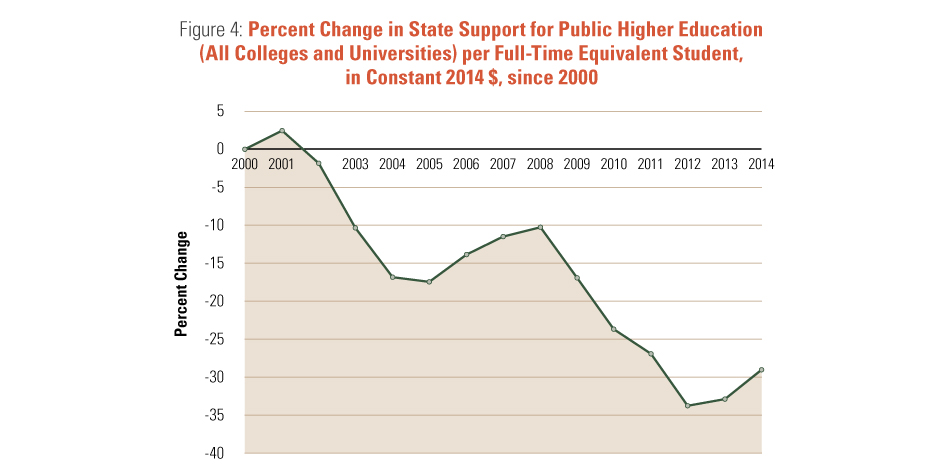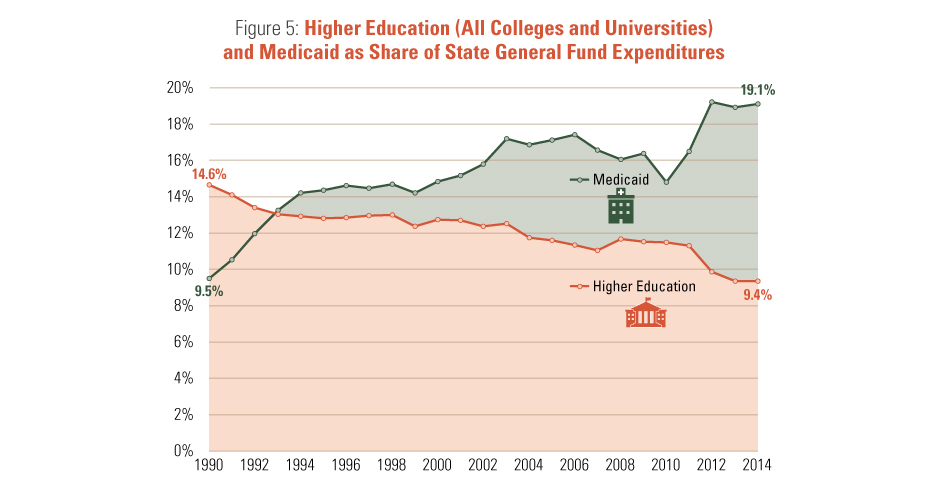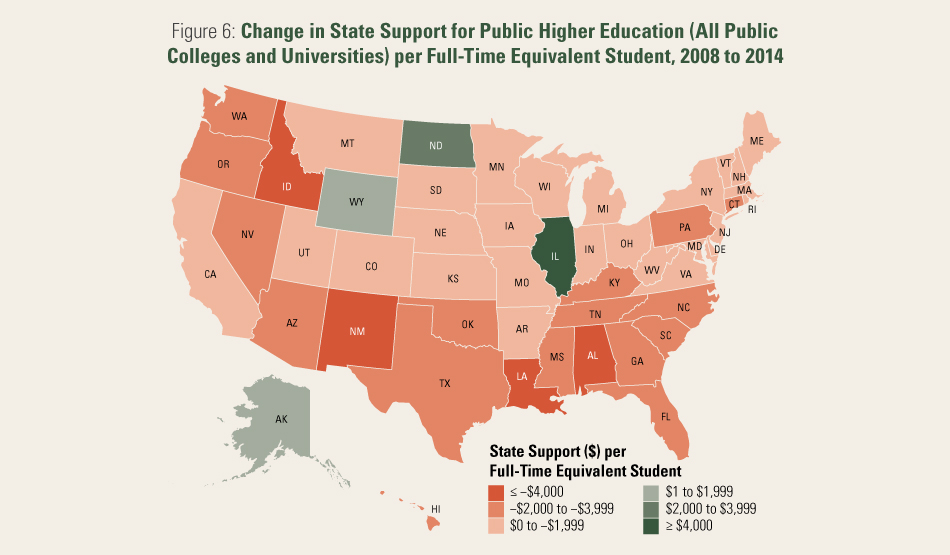Section 2: The Decline in State Funding
Overall, states have been cutting their support for higher education for well over a decade. Reductions were most dramatic between 2001 and 2004, and in the wake of the Great Recession and its accompanying decline in tax revenue. Although spending increased slightly in 2013 and again in 2014, these increases are dwarfed by the magnitude of prior cuts, and spending per FTE student in 2014 was nearly 30 percent below its level in 2000, after adjusting for inflation (see Figure 4). And in many states, even with a turnaround in the level of state funding, the situation has gotten worse due to corresponding tuition-increase freezes or caps. In states where tuition is constrained, universities are experiencing a net loss even when states do increase funding.

|
Despite modest increases in 2013 and 2014, state support for public higher education per full-time equivalent student remains nearly 30 percent below spending in 2000, after adjusting for inflation using the State Higher Education Finance cost adjustment. Source: State Higher Education Executive Officers (SHEEO) Association, SHEF: FY 2014—State Higher Education Finance (Boulder, Colo.: State Higher Education Executive Officers Association, 2015).

As a result of sustained cuts and governmental spending pressures elsewhere, higher education has declined as a share of state budgets. While states once spent more on higher education than Medicaid, higher education has been overtaken, and the gap is widening. The higher education share of general fund spending fell from 14.6 percent in 1990 to 9.4 percent in 2014, while the Medicaid share more than doubled, from 9.5 percent to 19.1 percent. States now spend more than twice as much on Medicaid as they do on higher education.

|
Higher education has fallen as a share of state budgets, while Medicaid has risen. Source: National Association of State Budget Officers, State Expenditure Report (various years, 1990–2014) (Washington, D.C.: National Association of State Budget Officers, 1991–2015), http://www.nasbo.org/publications-data/state-expenditure-report/archives.
Higher education has suffered relative to other priorities, too, particularly elementary and secondary education and corrections. According to one recent analysis, “eleven states spent more of their general funds on corrections than on higher education in 2013. And some of the states with the biggest education cuts in recent years also have among the nation’s highest incarceration rates.“8
In all, forty-six states cut support for public higher education per FTE student between 2008 and 2014, after adjusting for inflation (see Figure 6). And these cuts were deep: thirty-six states cut inflation-adjusted spending per FTE student by more than 20 percent, nineteen cut by more than 25 percent, and ten cut by more than 30 percent.9

State support for public higher education, per full-time equivalent student, is below the 2008 level in forty-six states. Although the map shows a substantial increase in Illinois, that does not reflect increased spending to support current students. Rather, it reflects an increase to support underfunded university pensions: support to pay for services delivered years or even decades in the past. Source: State Higher Education Executive Officers (SHEEO) Association, SHEF: FY 2014—State Higher Education Finance (Boulder, Colo.: State Higher Education Executive Officers Association, 2015).
ENDNOTES
8 Mitchell, Palacios, and Leachman, States are Still Funding Higher Education below Pre-Recession Levels.
9 Analysis derived from State Higher Education Executive Officers (SHEEO) Association, SHEF: FY 2014—State Higher Education Finance (Boulder, Colo.: State Higher Education Executive Officers Association, 2015). These numbers differ slightly from numbers in a report by the Center on Budget and Policy Priorities, likely because these numbers reflect updated data for 2014. See Mitchell, Palacios, and Leachman, States are Still Funding Higher Education below Pre-Recession Levels.